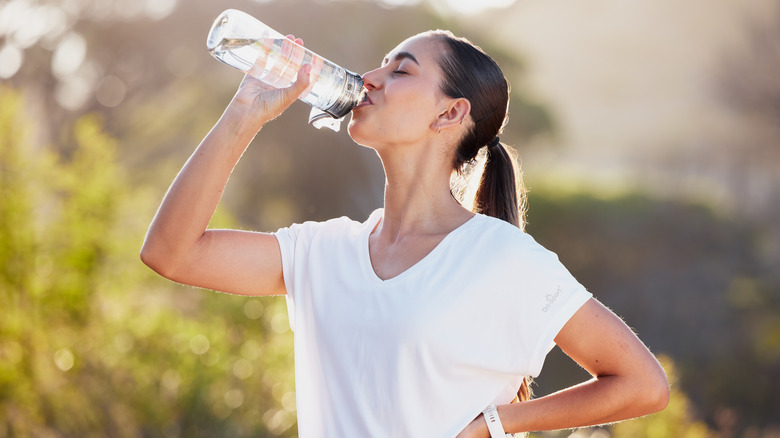You Can Actually Get Water Poisoning And It's Really Bad
We may receive a commission on purchases made from links.
Staying hydrated, particularly during exercise, is important to maintain the right balance of fluids and minerals in your body to support normal physiologic functions. The body depends on water to flush waste, perform major bodily functions, prevent constipation, and regulate temperature. But, while water is important for living organisms — especially humans — drinking too much can lead to water poisoning and a condition called hyponatremia, which can have concerning and serious effects.
Initially, the only indicator of water poisoning (or overhydration) is clear urine, which should actually be pale yellow like lemonade. If the overhydration isn't corrected, it can eventually lead to hyponatremia, which means that the sodium in the blood has been diluted to abnormally low levels. The problem is what sodium imbalance does to cells: they start swelling, which can cause a host of health issues.
Some people may feel confused, dizzy, or even drunk as a result, and they may be drowsy, have muscle cramps, or feel nauseous and vomit. Because of the cell swelling from hyponatremia, pressure in the brain can build and trigger headaches and nervous system malfunctions that may present as seizures. In extreme cases and without treatment, it can lead to coma and death.
How much water is the right amount to drink?
Because of the dangerous consequences of water poisoning, it's important not to drink more water than your body actually needs. Unfortunately, there are no official guidelines for how much water you should drink on a daily basis because how much water your body needs depends on your body weight, climate, level of physical activity, and sex at birth. For example, the body generally needs 1 ounce of fluid per 2.2 pounds of body weight, so if you weigh 140 pounds, you should consume about 64 ounces of fluids every day.
Take note that these figures are for total fluid intake, not just water. Your body retains fluids from coffee and tea, as well as a variety of foods, such as fruits, vegetables, and even ice cream and soup — anything that be liquefied or that becomes a liquid when it's left at room temperature. Also keep in mind that you'll need more fluids if you participate in a lot of physical activity or live in a hot climate because you'll sweat more and need to replenish those fluids.
However, it's important to note that drinking too much water isn't the only cause of hyponatremia and its related symptoms and complications. Certain diseases, medications, and hormonal changes can contribute, as can the loss of sodium and other electrolytes due to dehydration from chronic diarrhea or vomiting. For that reason, the same swelling from a sodium imbalance caused by water poisoning can happen to your cells when you are dehydrated. In such situations, it's essential to rehydrate with electrolyte-rich fluids, such as Pedialyte Electrolyte Solution, to bring sodium and water levels back in balance.

